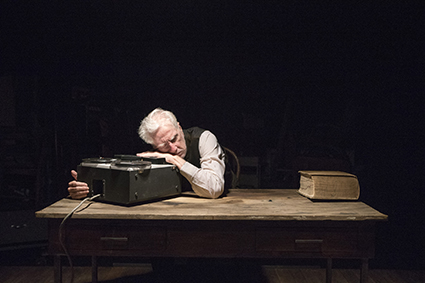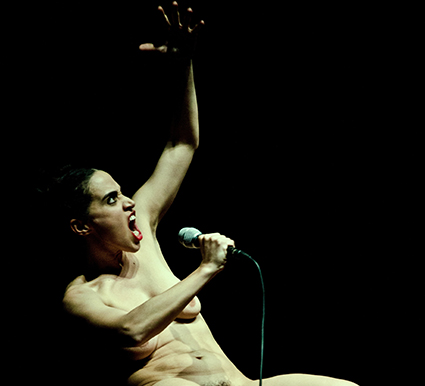The mind performs
Ben Brooker: Performance

Peter Carroll, Krapp’s Last Tape, Adelaide Festival of Arts
photo Shae Reid
Peter Carroll, Krapp’s Last Tape, Adelaide Festival of Arts
Whether through the vagaries of curatorial taste, the spectre of economic austerity or some untraceable shift in the theatrical ether, the actor in brutal isolation—tethered almost solely by text to stages dimly lit and emptied of relieving or easily symbolic dressing—dominated this year’s Adelaide Festival of Arts.
Beckett Triptych
The State Theatre Company of SA’s offering, Beckett Triptych, locates its three onstage soloists—Pamela Rabe (Footfalls), Paul Blackwell (Eh Joe) and Peter Carroll (Krapp’s Last Tape)—within the crepuscular atmospherics of the company’s subterranean Scenic Workshop and Rehearsal Room spaces. The audience, ushered between venues like visitors to the underworld, is divided in half for the first two dramaticules, which run twice in succession, then we are reunited post-interval for the climactic Krapp.
In Eh Joe, we watch through a scrim as Blackwell, in his “stinking old wrapper” of worn dressing gown and slippers, shuffles paranoiacally around Ailsa Paterson’s monochromatic, vaguely fabulist set that telescopes weirdly towards an upstage door. He checks under the bed–no monsters there—then slumps onto its end, submitting to some expected but unspoken consequence of bringing his body to rest. There he remains in silence for the remainder of the play as a woman’s disembodied voice (Rabe) torments him about his lascivious past and barren present, her clipped, accusatory voice an aural waterboarding. Joe’s face, crumpled and impassive, is projected via a video camera onto the scrim in a series of increasingly extreme close-ups. Finally, just his eyes—unnervingly massive and miraculously unblinking—fill the screen, windows onto a soul in ineffable anguish.
Director Corey McMahon’s montaging of live action and projected image, though not innovative (Canadian filmmaker Atom Egoyan employed both scrim and video feed in his 2006 production for Beckett’s centenary celebrations), is nevertheless an effective solution to staging a play originally written for television, its disturbing intimatisation of a mind under remorseless psychic assault undiminished by the shift in medium.
Like Joe, Footfalls’ May is persecuted by ghosts from a neurotically reproduced past; the present, as a result, is rendered a sleepless purgatory. “Will you never have done…” the voice of May’s mother (Sandy Gore) asks in the low, drawn-out timbre the characters familially share, “…revolving it all? In your poor mind.”
Rabe looks like the “tangle of tatters” to which May elliptically refers, face drawn and pallid, hair overlong and dishevelled (the only mistake is the Victorian-style dress, a too elaborate and loaded interpretation of Beckett’s call for a “worn grey wrap”). But for the audible, mathematical tread of her feet on the worn strip of floor beneath her, Rabe is spectral in Ben Flett’s narrow, starkly contrastive lighting. She looks, occasionally, monstrous as she leans disfiguringly out of the light, or like the tortured figure in Munch’s The Scream as her mouth yawns soundlessly open. Here, perhaps more than in any of Beckett’s other short plays, the role of the director is akin to that of a conductor—the rhythmical progression implied by the play’s title and inherent in its text demands to be both physically and verbally realised—and in this Geordie Brookman keeps time admirably.
It’s somewhat mystifying that Footfalls is followed in the triptych not by That Time, written specifically to accompany it, but Krapp’s Last Tape, the longest and most familiar of Beckett’s shorter plays for the stage. It stands apart from the other two pieces presented here in other ways too, namely that Krapp’s private perdition (for what are each of these plays but inversions of Sartre’s dictum that hell is other people?) is ultimately, if incompletely, reconcilable: “Perhaps my best years are gone,” he says, “but I wouldn’t want them back. Not with the fire in me now.”
This impression is strengthened by Peter Carroll’s performance as Krapp, in which, under the direction of Nescha Jelk, the clowning Beckett minimised in his later revisions of the play is fully reinstated. The result is a slightly fussy, childlike Krapp, less visibly haunted than in many previous incarnations that, however unreliably remembered, cannot be easily forgotten—Patrick Magee, John Hurt. While at times I yearned for more of the gravitas those actors brought to the part, at least neither Carroll nor Jelk mistake ponderousness for insight, a trap into which both lesser and greater interpreters of Beckett have fallen. The production’s one true shortcoming is Paterson’s overdesigned set, a crudely symbolic and needlessly focus-pulling array of middens on trolleys that threatens to overwhelm the only detritus of moment, that of the ultimate unreconstructed hoarder, the human mind.
SmallWaR
It is the body, at least at first, that is the site of trauma in SmallWaR, a companion piece to Belgian writer/performer Valentijn Dhaenens’ BigMouth that substitutes the earlier play’s cast of powerful, militant orators—Patton, Goebbels, George W. Bush—for one of doomed youth, ordinary soldiers destined to die, in Wilfred Owen’s words, “as cattle.”
A truncated gurney is wheeled onto the stage in front of a giant scrim by Dhaenens, dressed in the starchy, army green uniform of a World War I nurse. Fixed to the bed is a flat screen TV on which pre-recorded vision plays: Dhaenens again, this time a limbless, prostrate soldier, only his head and shoulders visible atop crisp white sheets. He is silent and motionless. The nurse sings softly: “There was a boy, a very strange, enchanted boy.” Multiple, ghostlike duplicates of the soldier peel away and cross the stage to answer a phone, the almost seamless transition between video and projection stunning. On the other end of the line are fathers, mothers, lovers—each voiced with skilful differentiation by Dhaenens—who, as with the letters and memoirs which form the basis of much of the script, wrestles with war’s teleology as well as its lived reality. “When you look death in the face,” one of the soldiers muses, “do you think of democracy, freedom and honour?”
There is, refreshingly, little here in the way of simplistic anti-warism, but a late, awkward turn into a seemingly unironical jingoism—evidenced by, for example, the appearance of the words “It is sweet and right to die for your country”—propels the work too far in the opposite direction. It was Owen, after all, who called Horace’s phrase, originally set down in Latin in Odes, “the old lie.”

Silvia Gallerano, La Merda, Adelaide Festival of Arts
photo Valeria Tomasulo
Silvia Gallerano, La Merda, Adelaide Festival of Arts
La Merda
A woman (Silvia Gallerano) perches naked on the edge of a tall, pedestal-like chair, clutching a microphone into which she is mumbling the words of what sounds like the Italian national anthem. Her lips, quivering and almost cartoonish, are bright red, her body pale and unforgivingly exposed in the cold glare of multiple spotlights. “Yes I’m a small one,” she says, pianissimo, in the first of the three movements (and one counter-movement, “Italy”) that make up Cristian Ceresoli’s monologue, “and I’ve got these thighs of mine but still I never quit and never give up.” An actor in desperate pursuit of fame whose fascist father killed himself when she was 13, she has the rusted-on look of someone on the verge of a breakdown or, perhaps, a breakthrough that never quite arrives. The howling, narcissistic crescendos (“me, me, me, meeeeeee”) that end each movement, plunging the theatre into darkness and silence, presage a negation of the self that can only be brief and temporary—the ego, insatiably hungry, must always return to cannibalise its host.
La Merda (in English, The Shit) is not, however, merely an atomistic study of neurotic obsession with body image and celebrity. It reveals, through the actor’s grotesque evocations of various men—an odious TV director, her father, sexual predators in school and on the subway—a culture of nationalistic masculinity that connects the Italy of Garibaldi to those of Mussolini and Berlusconi, a lineage that traces the country’s journey from, in Pasolinean terms, a fascist to a consumerist totalitarianism. “The male sex our flag, the male sex our flag,” Gallerano spits at the conclusion of the monologue before clothing her body in a green, white and red flag—an ambivalent gesture freighted with both embracement and resistance. A charged silence hardens, after what seems like a minute or more, into a standing ovation that justly rewards a performance of startling intensity and import.
riverrun
Olwen Fouéré, adapter, director and performer of this one-woman interpretation of the voice of the river in Finnegans Wake, has described James Joyce’s modernist apogee–“admired more often than read, when read rarely through to the end, when read through to the end not often fully, or even partially, understood,” according to Anthony Burgess—as “a seam of dark matter somewhere between energy and form, music and language: the trace of a boat on an endlessly changing surface.” Fouéré, in a virtually uninterrupted monologue that freely splices together passages from all over Joyce’s infamously sprawling text, is at once vessel and waterway, embodying both the river’s sinuous, dreamlike course that ultimately circles back on itself (the novel’s final sentence, which has no full stop, leads back to its first word, riverrun, which has no initial capital) and the shadowy characters who drift and drown in its currents.
Coiled, shifting like a prizefighter on the balls of her feet, Fouéré begins with a dawn prayer, three words in Sanskrit that are found in Finnegans Wake at the opening of Book IV, the beginning of the novel’s final section: “Sandhyas! Sandhyas! Sandhyas!” The jagged stand of Fouéré’s microphone and its lead’s tracing of the edges of a vast patch of chalk evoke the uncertain, meandering quality of the flow of bodies of water, but it is the topographies of the body and of language that are foregrounded here. Joyce’s multilingual, polysyllabic wordplay is given endlessly fluid shape by Fouéré’s sinewy, gestural physicality and almost schizophrenic vocalisations. She hisses, growls, murmurs, sings and, quite literally, breathes the river—Dublin’s Liffey, personified in Finnegans Wake in the character of Anna Livia Plurabelle—into life.
The elusiveness of Joyce’s text is unquestionably amplified in its transition to the stage. The audience member, unlike the reader, never has the luxury of pausing its inexorable flow to dig deeper into its strata of meaning, or to fully unpack its complex puns or allusions to Irish history. But, as Beckett, a close friend and aide of Joyce’s, noted, “[Joyce’s] writing is not about something; it is that something itself.” That something is, in essence, a dream conveyed through language rendered as music, and it is in the splendid, endless noise of Fouéré’s furious unintelligibility that the pleasures of riverrun arise.
Adelaide Festival 2015, Beckett Triptych, State Theatre Company, 20 Feb-15 March; SmallWaR, SKaGeN, Space Theatre, 2-4 March; La Merda, Space Theatre, 5-8 March; riverrun, Dunstan Playhouse, Adelaide Festival Centre, 26 Feb-2 March
RealTime issue #126 April-May 2015 pg. 10






